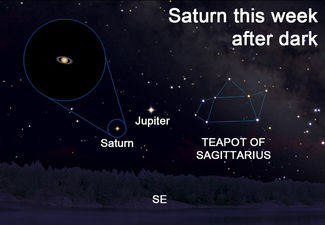Saturn: Lord of the Rings
Last updated 7/30/2020 at 9:17am

As you gaze at Saturn, keep in mind that it's a world made almost entirely of gasses with a diameter about 9.5 times greater than the Earth's
If I were to ask which you think is our Solar system's most beautiful planet, how would you respond?
Some would answer that the red planet Mars or the glistening planet Venus beat all others. Some might argue that the Earth is the most beautiful of all. These all are legitimate contenders, but if you've ever peered through a telescope at the ringed planet Saturn, you will almost certainly choose the "Lord of the Rings."
Saturn reaches its annual "opposition" point on July 20, when it appears in our sky opposite the sun, rising in the southeast at sunset and glistening all night long.
You can find Saturn appearing as a bright "star" east of the summertime grouping known as the "Teapot" of Sagittarius. You should have little trouble finding it because, this month, it lies just to the left of the brilliant planet Jupiter.
Saturn's opposition means not only that it lies opposite the sun in our sky but also that it's closest to the Earth. Right now Saturn lies only about 836 million miles from us and produces a marvelous view through a small telescope.
If you've never gazed at this planet for yourself, you have no idea what you're missing. Everyone's first view elicits a gasp of wonder, as the remarkably three-dimensional ringed world appears hanging in the blackness of space.
Even a small instrument with a magnifying power of only 30x or so will easily show its rings. Of course, if you have a higher magnification eyepiece to attach, along with a night with steady air, you'll be treated not only to the ring system but also to the major separation within known as the Cassini Division.
Sometimes, you may even spot some of the planet's pastel cloud bands, but they are pretty subtle and need excellent conditions and optics to become visible. If that's not enough, Saturn's largest and brightest moon, Titan, also frequently appears with even the smallest of instruments, as do several of its smaller moons.
Making the sight even more breathtaking is an appreciation of what we're actually seeing. As you gaze at Saturn, keep in mind that it's a world made almost entirely of gasses with a diameter about 9.5 times greater than the Earth's.
Its rings -- if brought here -- would fill much of the space between the Earth and our moon. Though they appear solid to the eye, they are really composed of billions of individual ice chunks -- ranging in size from dust grains to boulders to mountains -- and all revolving about Saturn at tens of thousands of miles per hour. In other words, whirling around Saturn are billions of moons!
While its opposition occurs officially next week, that doesn't mean this is the only time that Saturn will shine at its best. It will remain in our evening sky throughout the summer and autumn months, but only during the next month or so can we expect the largest view with a small telescope.
One glimpse at this stunning ringed world will make it easy for you to agree that it is -- without question -- the most stunningly beautiful planet!



